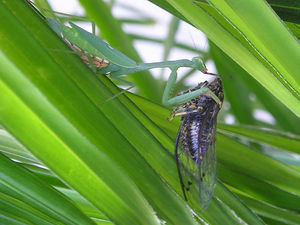Biological pest control
Main > Food and Agriculture > Pests and weeds
Biological pest control (also called Integrated Pest Management) relies on useful organisms to deal with pest organisms. If you have grasshoppers destroying your vegetables, see it as an opportunity! Those grasshoppers represent energy and biological matter in your garden and all you have to do is convert that into a more desirable form. You can do this by getting turkeys; a turkey can transform 3kg of grasshopper into 1kg of valuable meat. A particularly effective technique is to use one plant that repels the pest, and another that attracts it away from the food crop. See push-pull technology.
Some mushrooms can advantageously be grown to repel pest insects such as aphids, grasshoppers, termites and others. See Wikipedia's page on entomopathogenic fungi and our page on mushrooms.
Useful online tools for planning biological pest control
- Biorationals: Ecological Pest Management Database - A tool where you select your pest and it gives a list of predators. Focused on North America.
- Lists suppliers of beneficial organisms in North America
- APHIS National Biological Control Institute (NBCI) - USDA Animal and Plant Health Service
- APHIS Plant Protection Centers - USDA Animal and Plant Health Service
- Auburn’s Biological Control Institute (BCI) - Auburn University
- Cornell’s Biological Control Home Page - Cornell University
- Florida Agricultural Information Retrieval System - University of Florida
- Florida’s National IPM Network - University of Florida
- NEB Guide - Biological Control of Insect and Mite Pests - University of Nebraska Cooperative Ext.
- North Carolina’s National IPM Network - North Carolina State University
- North Carolina State BioControl Contents - North Carolina State University
- Purdue’s Biological Control Laboratory - University of Purdue Cooperative Extension
- University of California IPM Home Page - University of California at Davis
